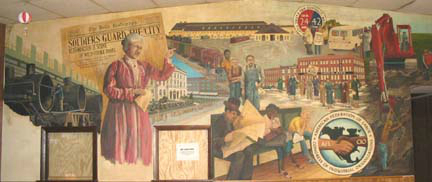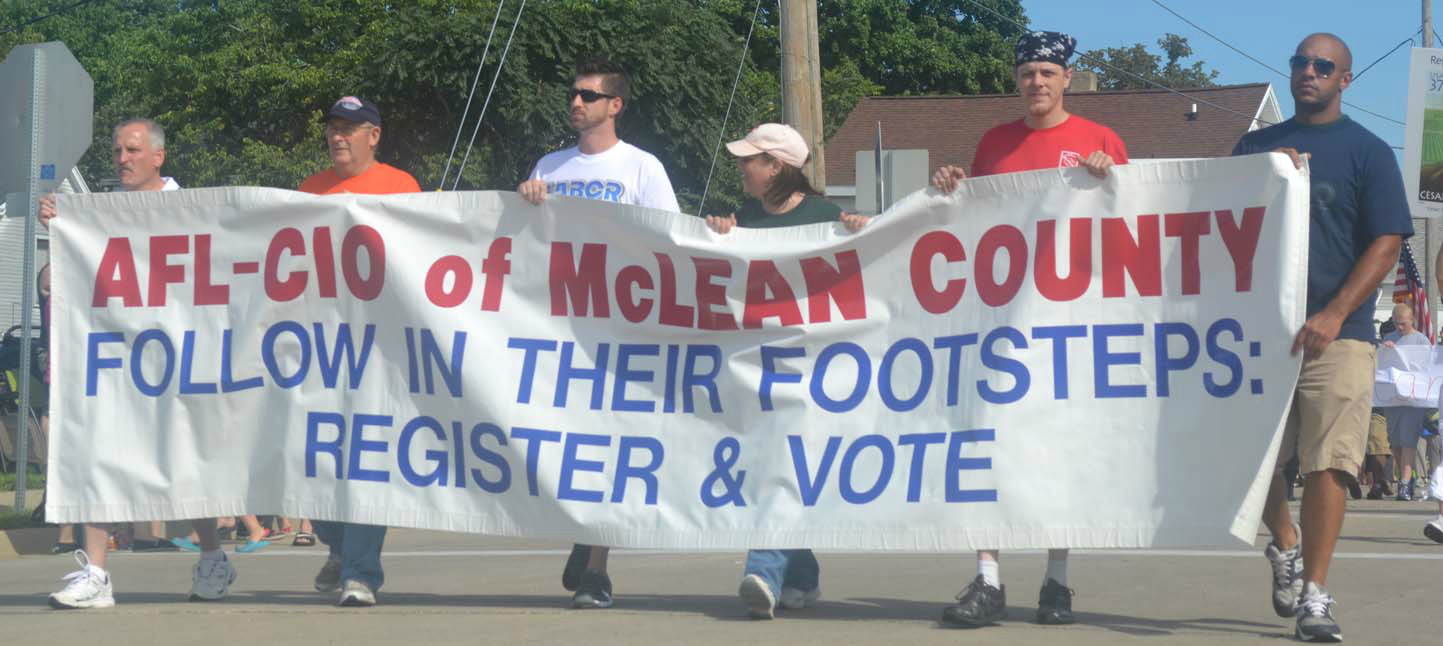|
Born and raised on Bloomington’s west side, Patrick Henry Morrissey became a national labor leader in his early thirties. As grand master (or president) of the Brotherhood of Railroad Trainmen from 1895 to 1909, Morrissey was known as a friend to the rank and file, and a frequent visitor to the White House.
Born Sept. 11, 1862, to Mary and John Morrissey, “Pat” grew up on the 800 block of West Monroe Street. Dominating the west side at this time was the Chicago & Alton Railroad, the heavily trafficked freight and passenger line connecting Chicago to St. Louis and used today by Union Pacific and Amtrak. The C&A depot was on the west side, as were the railroad’s sprawling shops and yards where locomotives and railcars were maintained, repaired and refurbished.
The working-class Morrissey family prized education, and the children attended school long after most of their west side peers had entered the labor force. That’s not to say a young Patrick Morrissey didn’t work during his school years. Education of a different sort occurred in and around the C&A Shops where he found employment as a call boy. “Before the days of telephones, a call boy’s job was to roust train crews and let them know when their next run would be,” noted local labor historian and community leader Mike Matejka in his 1989 biographical sketch of Morrissey. “This included rapping on bedroom windows in the middle of the night, or tracking down trainmen at restaurants, poker games or taverns.”
Morrissey graduated from Bloomington High School in 1879. There were 27 students in his graduating class and he was one of only five males. He then made his way to Chicago where he worked for a grocer, though he was soon drawn back to Bloomington’s west side and the world of railroading. By 1880 he was a clerk to a C&A master mechanic, while his later jobs included freight brakeman and conductor.
In this age of raw capitalism workers were often treated as little more than expendable parts in a cruel industrial and commercial machine designed to concentrate wealth into the hands of the robber baron class. This was the Gilded Age, a time of vast economic inequality unmatched in U.S. history (until today that is!)
In this unregulated economic order there were few livelihoods as dangerous as that of a railroad brakemen. In an era before air brakes, this job entailed traversing a moving train topside and setting brakes for each railcar out in the raw elements. Imagine doing that job atop a swaying, jostling train, to say nothing of facing heavy winds, rain, ice or snow. Brakemen were also responsible for coupling and uncoupling cars using the dangerous link-and-pin system. This action required brakemen to stand between two rail cars and guide an elongated iron loop or link from one car to the coupler pocket of the other. As the link and pocket were drawn together the brakeman would drop an iron pin into an opening of the now-joined loop and coupler to hold them together. Needless to say, this was as dangerous as it sounds. Brakemen often caught their fingers or entire hand in the coupler, or were crushed between the cars. “A supervisor could hire experienced trainmen by the number of fingers missing,” added Matejka.
Federal and state workers' compensation did not exist when Morrissey began his railroading career, and private insurers often refused to cover such dangerous occupations. Thus the early railroad unions known as brotherhoods, including Morrissey’s Brotherhood of Railroad Trainmen, doubled as mutual insurance societies. Organized along job type — engineers, firemen, conductors, brakemen —brotherhoods were a hybrid of fraternal society and labor union. At a time when workers had few rights or protections that would allow them to organize and strike, the brotherhoods were relatively conservative, preferring “to establish mutual confidence, and create and maintain harmonious relations” between the owners and producers of capital.
Brakemen organized a brotherhood in 1883, and two years later Morrissey and about 30 other local brakemen and switchmen became charter members of the Bloomington lodge (as chapters or locals were known). Elected later that year to attend the brotherhood’s third national convention, Morrissey impressed the newly elected grand master enough to be offered a job at the brotherhood’s national office in Galesburg. In 1890, the Brotherhood of Railroad Brakemen became the Brotherhood of Railroad Trainmen so it could represent a wider range of rail and yard positions, including conductors, baggage handlers, ticket collectors, flagmen and dining car stewards.
Four years later, in 1894, the American Railway Union (ARU) staged a strike against the Pullman Palace Car Co., a Chicago maker of railroad sleeping cars. The strike’s determined leader was Eugene V. Debs, a former secretary of the Brotherhood of Locomotive Firemen who believed that an industry wide union such as the ARU would better serve the interests of railroad workers. The more cautious Brotherhood of Railroad Trainmen opposed the ARU and even booted members who supported the Pullman Strike.
When a 32-year-old Morrissey took the reins of the BRT in 1895 the organization was in “deep distress.” The Panic of 1893 (“panic” was a once-popular term for a steep economic downturn) and the Pullman Strike had decimated the brotherhood’s membership rolls and finances.
During Morrissey’s 14 years as grand master, the BRT returned to national prominence and continued its evolution from fraternal society to labor union. His regime likely made its greatest mark by negotiating standardized railroad wages and working conditions within regions of the country. And under his leadership the brotherhood’s membership increased from 10,000 to 120,000. The former Bloomington brakeman’s willingness to bridge the gap between big business and organized labor made him a trusted ally of Progressive Era President Theodore Roosevelt, who proved far more supportive of labor than most of his fellow Republicans. “The only prominent labor leader I ever met who was as good a citizen, as good an advisor politically, and as broad and practical a worker for social justice as the best of our people generally, was Patrick Morrissey,” Roosevelt wrote to British statesman Winston Churchill.
Morrissey stepped down as head of the BRT in 1909. He passed away on Nov. 28, 1916 at his Galesburg home; the cause of death said to be a brain tumor. He was 54 years old. Long afterward Morrissey remained a beloved figure of the Brotherhood of Railroad Trainmen. During World War II the BRT succeeded in getting a Liberty ship (a famed class of cargo vessel) named for their former grand master. The “S.S. Patrick H. Morrissey” was christened Dec. 7, 1943, at Brunswick, Ga.
by Bill Kemp, archivist, McLean County Museum of History, published in the Bloomington Pantagraph, January 10, 2016
Download:
|



